At first glance, Go My Query looks like a legitimate search engine site, but the numerous user complaints about it caught my attention, so I decided to investigate further. Turns out this is nothing more than a browser hijacker, similar to Maxask or Securevault, that secretly embeds itself into the browser and forces redirects each time the user attempts to search for anything.
After Go My Query (go.myquery.net) becomes the browser’s default search engine, it starts rerouting your searches through a series of pages in a quick succession before landing you on another rogue search engine called Fast Search.
The goal is to gather your browsing data and also to display promoted results in the search results page. Many of those results could plan you on harmful pages, where you might become a victim of phishing scams or accidentally download malware.
The obvious solution is to remove the hijacker alongside anything that might have come alongside it. I’ll help you do that with the following guide.
Go My Query Removal Steps
Hijackers have different ways of getting inside your browser. The way you got Go My Query largely defines how easy it’s going to be to remove it. In some cases, you can get rid of it pretty easily, using less advanced steps:
- Open the affected browser, click its menu, and open settings.
- Select Extensions or Add-ons. Look over the list of installed extensions. Look for suspicious items – extensions you don’t recognize or that you didn’t install intentionally.
- Disable and remove any suspicious extensions if their “Remove” button is available.
- Now, check the Privacy and Security settings. Find Site Settings here. Microsoft Edge users, look under Cookies and Site Data.
- Check the “Notifications” and “Pop-ups and Redirects” sections for go.myquery.net or other rogue websites permitted to use them.
- Delete/block any rogue sites you see there.
Complete these steps, then restart the computer. Reopen the browser afterward. If Go My Query persists, advance to the full guide below, where you’ll find more advanced removal steps.
SUMMARY:
| Name | Go My Query |
| Type | Browser Hijacker |
| Detection Tool |
Some threats reinstall themselves if you don’t delete their core files. We recommend downloading SpyHunter to remove harmful programs for you. This may save you hours and ensure you don’t harm your system by deleting the wrong files. |
The full guide will take an hour or more to complete and you’ll need to have at least some base level of troubleshooting experience to perform everything smoothly. If you lack the time or confidence to complete this guide, my recommendation is to use SpyHunter 5 to remove the Go My Query hijacker.
SpyHunter 5 is a powerful removal solution that you’ll find on this page and it can help you deal with Go My Query in only a couple of clicks.
How to Remove the Go My Query Virus
The thing that’s most likely keeping you from removing Go My Query is a rogue policy added by the hijacker to your browser. You can easily see if that’s the case by clicking the browser’s menu. If there’s a “Managed by your organization” at its bottom, then there’s an active third-party policy you must deal with first:
Access your browser’s Policy Page. In Chrome, type chrome://policy;
- for Edge, edge://policy;
- for Brave, brave://policy.
Look for suspicious policy values – strings of random characters in the Value column.
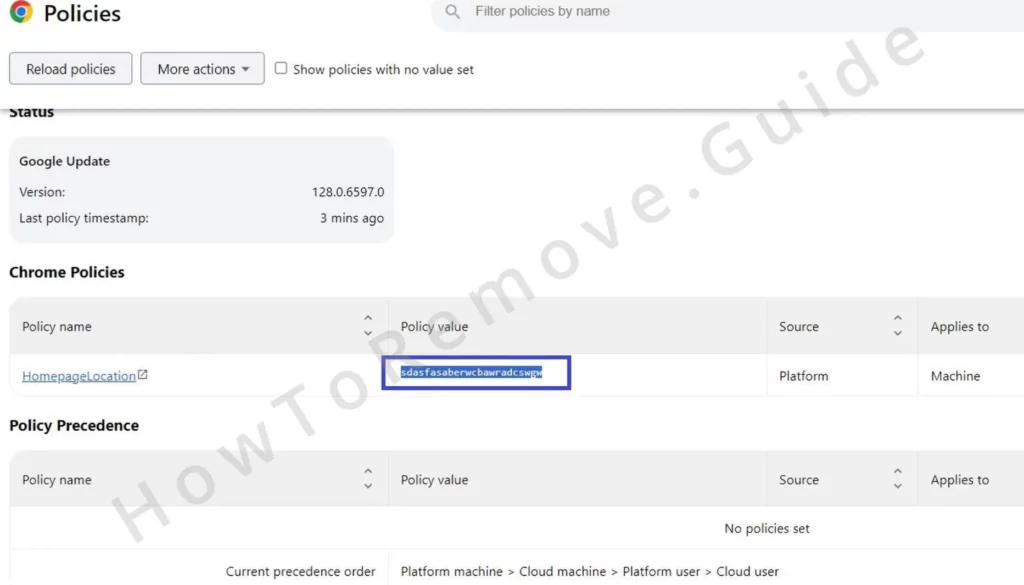
Copy each policy’s value, then save it in a text file for reference. They’ll guide you through eliminating the hijacker’s backend control.
You’ll also need the IDs of any rogue extensions in your browser. Go to Settings > Extensions > Extensions Manager to get them.
Sometimes, the hijacker might stop you from going there by rerouting you to external sites. The solution:
Navigate to your browser’s extension directory. For Chrome, the directory path is C:\Users[Your Username]\AppData\Local\Google\Chrome\User Data\Default\Extensions.
The extension folder paths for other popular browsers:

Once there, delete the contents of that folder.
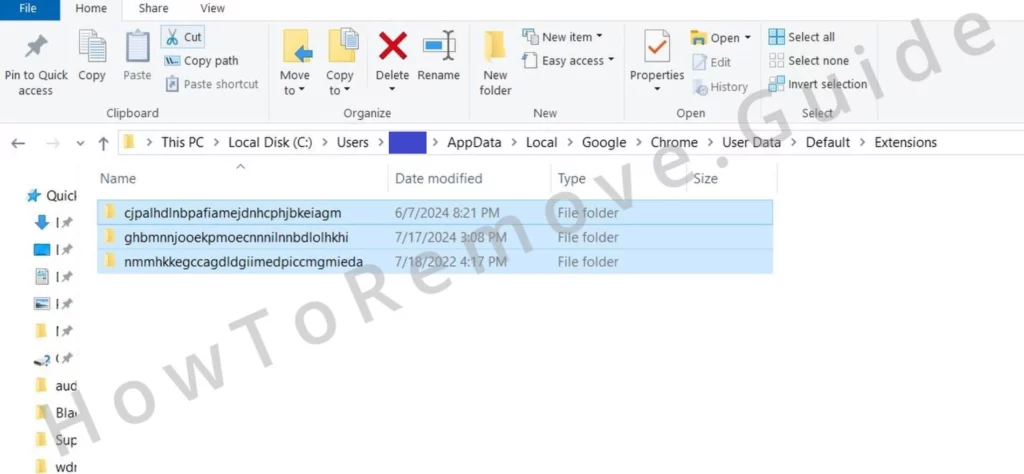
Deleting all extension folders clears every add-on, good and bad. A clean slate for your browser, with legitimate extensions reinstalled later if needed.
Afterward, return to the Extensions Manager, activate Developer Mode, and review IDs for each extension. Identify lingering Go My Query-linked items using these IDs. Keep notes in the same text file.
Video walkthrough for this step:
Delete the go.myquery.net Malware Policy From the Registry Editor
You have the data needed to hunt down the rogue Go My Query policy within your system registry. It’s now time to use it.
You must visit the Registry Editor, search for each value and extension ID you saved in the previous step, and delete related items:
- Open the Registry Editor from the Start Menu with administrative access.
- Use Find (Ctrl + F) to search each documented policy value. Each match requires deletion of the related registry key.
- Delete one policy key, then search again to find and delete the next. Continue this pattern until no entries remain.
- Follow this process for each value and extension ID.
You might get blocked from deleting some of the keys. If access denial occurs, right-click the “parent” key above the problematic one.
Select Permissions, open Advanced, then click Change. Type “everyone” in the field, click Check Names, and apply the changes.
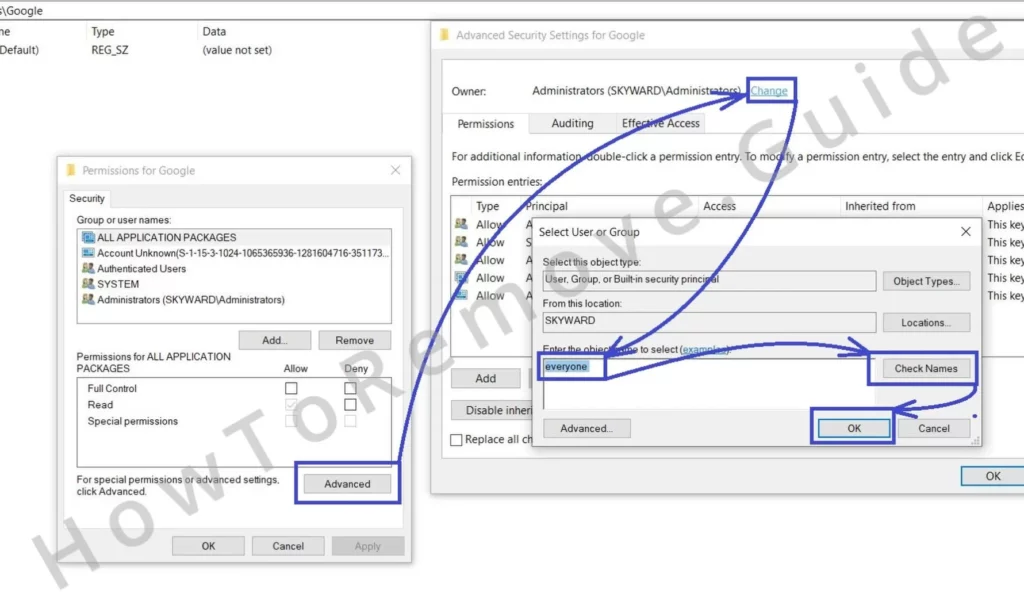
In the previous window, tick the two Replace options, then click Apply and OK again.
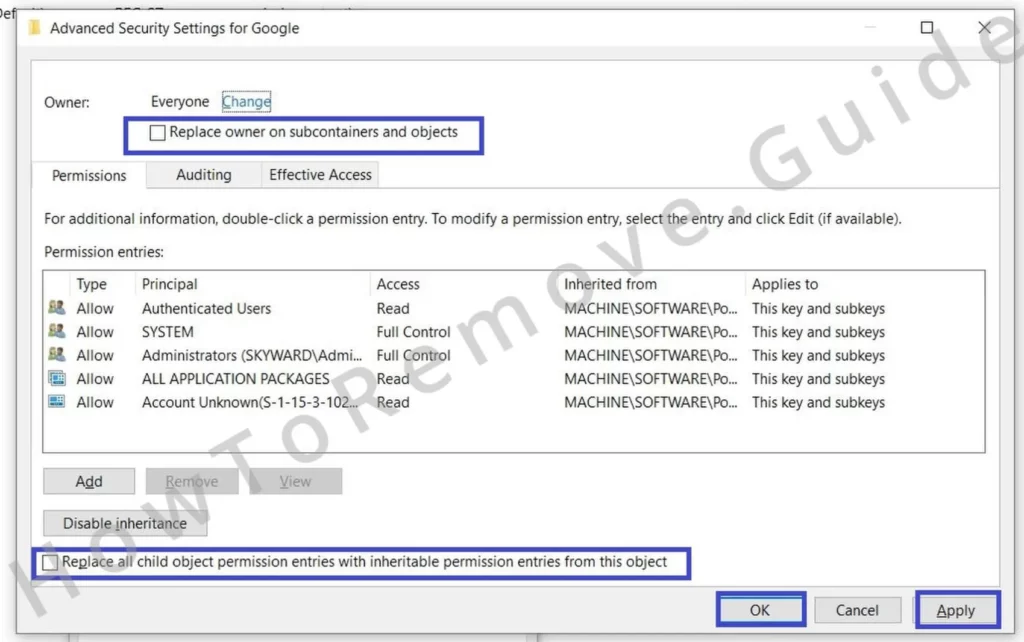
This adjustment provides necessary access to delete those resistant keys.
Video walkthrough for this step:
Other Ways to Get Rid of Go My Query Virus Policies
If the Registry cleanup method seems too convoluted to you or if it simply didn’t work and there are still rogue Go My Query policies in the browser, I suggest trying the following two alternative methods:
Open the Run dialog (Win + R), type gpedit.msc, and press Enter.
Find Local Computer Policy > Computer Configuration.
Right-click Administrative Templates, select Add/Remove.
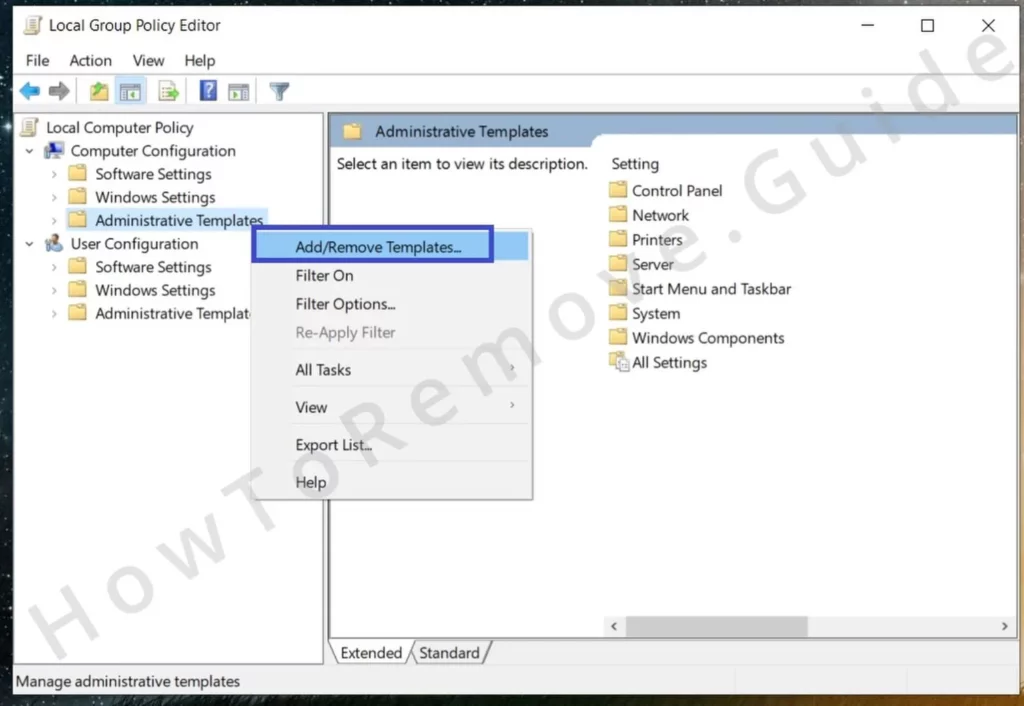
Remove any unfamiliar templates. This should get rid of any remaining Go My Query policies.
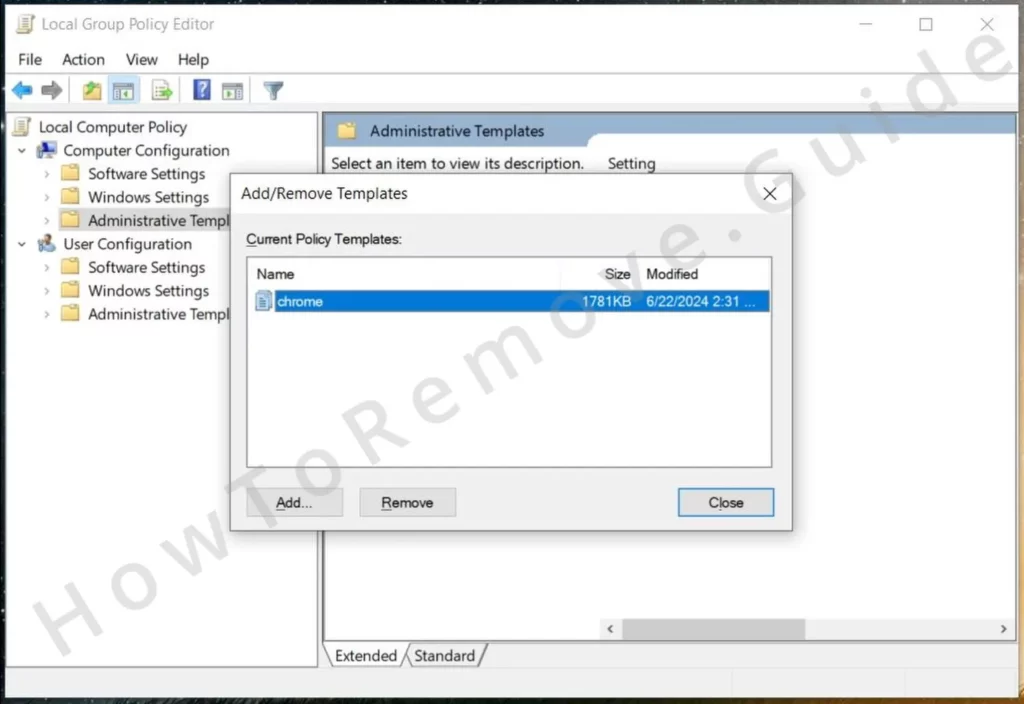
If the browser you are trying to clean is Google Chrome, there’s an even quicker way – a free tool called Chrome Policy Remover.
Download the tool, run as an administrator, and proceed despite any security warnings – the tool is perfectly safe, so just click More Info > Run Anyway if Windows shows a security alert.
Once the tool launches, it will automatically run a policy-deletion script for Chrome that will get rid of any remaining Go My Query policies.
Video walkthrough for this step:
Manual Group Policy Removal
Automatic Group Policy Removal
How to Remove GoMyQuery From Chrome, Edge, and Other Browsers
Time for the final browser cleanup. By now, you should have been able to eliminate the Go My Query policy which unties your hands to reverse any unwanted changes made in the browser’s settings:
Open the browser and once again go to Extensions (or Add-ons).
Look for any extensions potentially tied to Go My Query. Delete anything suspicious.
Next, proceed to clear browsing data. Under Privacy and Security, choose Delete Browsing Data. Select “All Time” as the time range and tick all boxes except passwords.
Click Delete and allow the browser to clear the data.
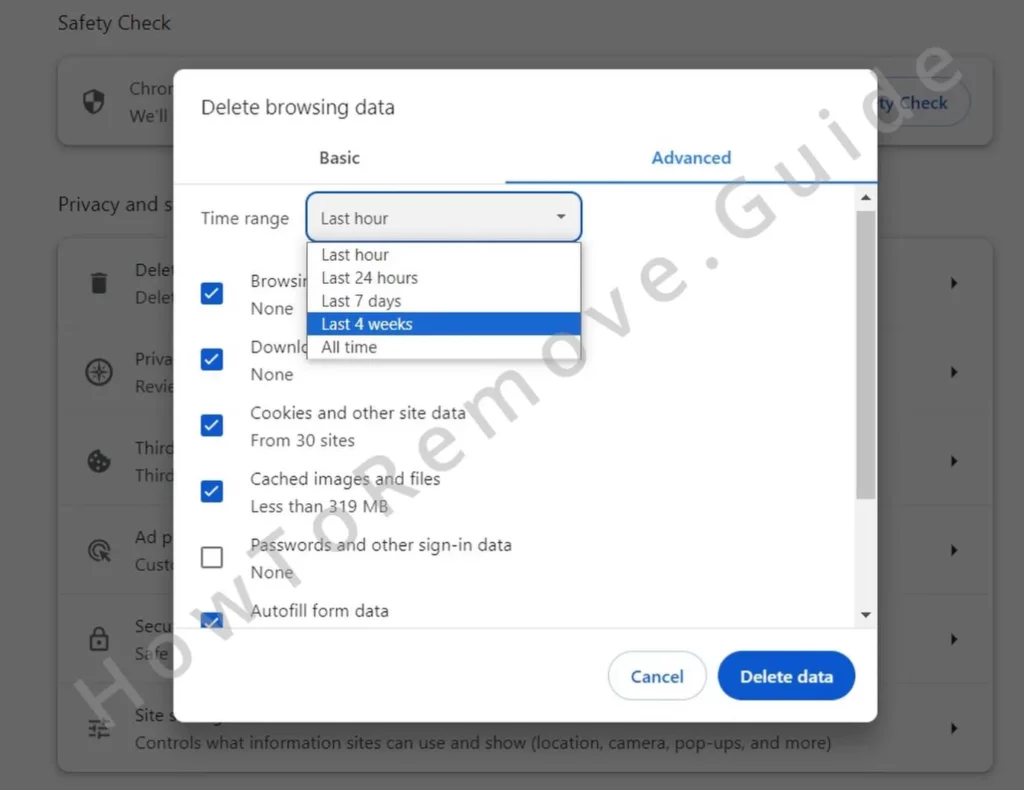
Now, review Site Settings. It’s under Privacy and Security for Chrome. For Edge, you must click on Cookies and Site Permissions from the left.
Unknown or unauthorized sites like go.myquery.net with permissions require immediate removal. Check all permission types and block/remove anything suspicious.
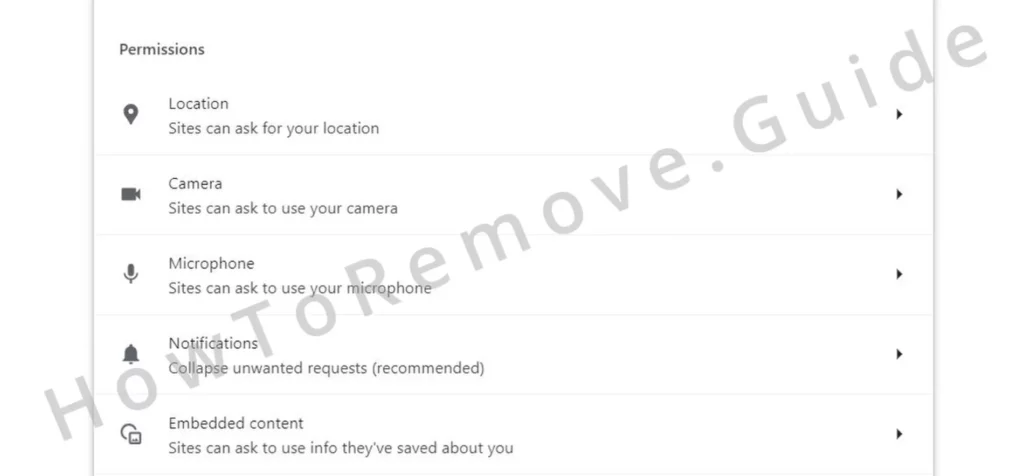
Choose a trusted search engine as the default in Search Engine tab.
Eliminate unrecognized entries under Manage Search Engines.
Then, in the On Startup tab, delete any suspicious URLs like go.myquery.net found in the homepage or startup settings.
Do the same thing in the Appearance settings, clearing rogue URLs from themes or other areas.
Video walkthrough for this step:
Chrome
Microsoft Edge
Mozilla Firefox
Identifying Residual Programs: Final Cleanup Steps to Fully Remove Go My Query
Persistent issues? A hidden program likely exists in your system, reinstalling Go My Query. Open Apps & Features within system settings and review installed programs. Uninstall any unrecognized or suspicious items, though resistance may occur with certain software. Manual removal sometimes proves challenging with particularly invasive software.
If manual deletion fails, advanced anti-malware tools offer a reliable solution. SpyHunter 5 scans systems thoroughly, identifying hidden programs linked to Go My Query. Download and run SpyHunter 5. Follow its instructions for complete malware elimination, a recommended approach for users unable to locate the source of the hijacker. Reliable software for thorough cleanup.
Final Words of Caution: Preventing Future Hijacker Infections
Preventing hijackers like Go My Query demands a proactive approach. Download software and extensions only from official sites. Avoid clicking suspicious links or downloading attachments from unknown sources. Common entry points for hijackers often include disguised links and malicious downloads.
Regular browser security checks help reinforce your defenses. Enable pop-up blockers and restrict permissions to trusted sites alone. Investing in a quality antivirus program with real-time protection strengthens these defenses. Necessary for ensuring a safe online environment.
Hijackers exploit overlooked security weaknesses, so a vigilant approach prevents future issues. Frequent system reviews maintain browser cleanliness and reduce exposure to similar threats. With mindful browsing habits, you’ll secure a browsing experience free from unwanted hijackers like Go My Query.

Leave a Reply